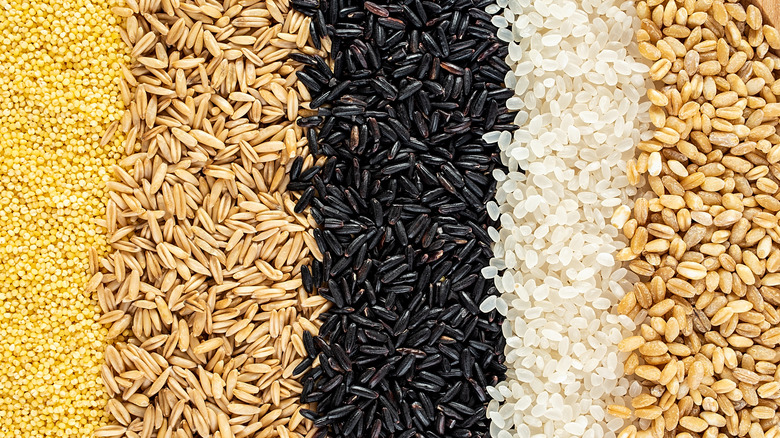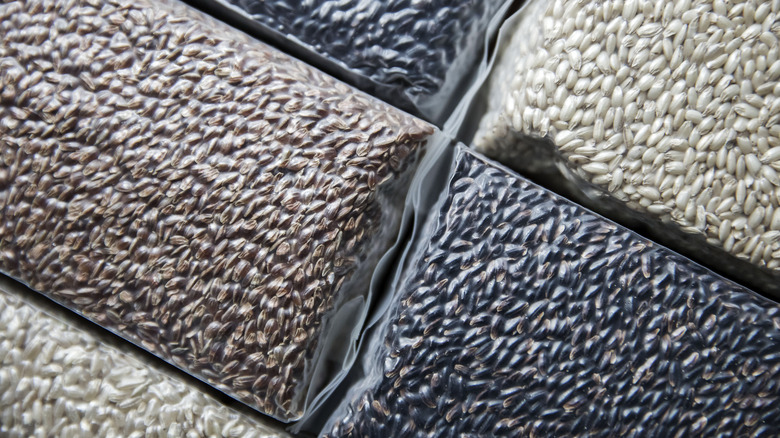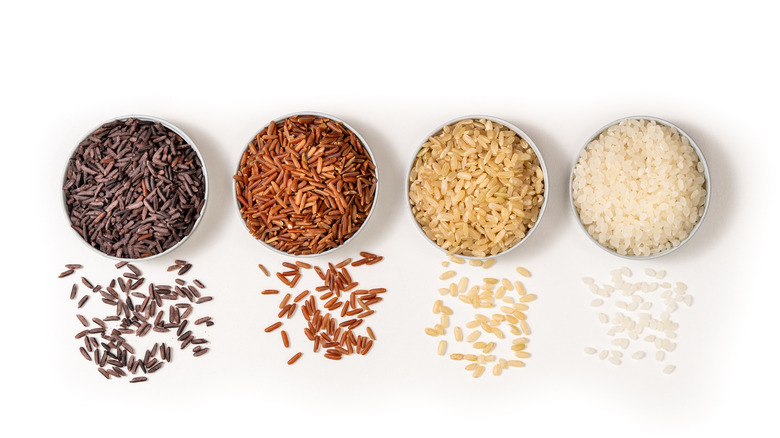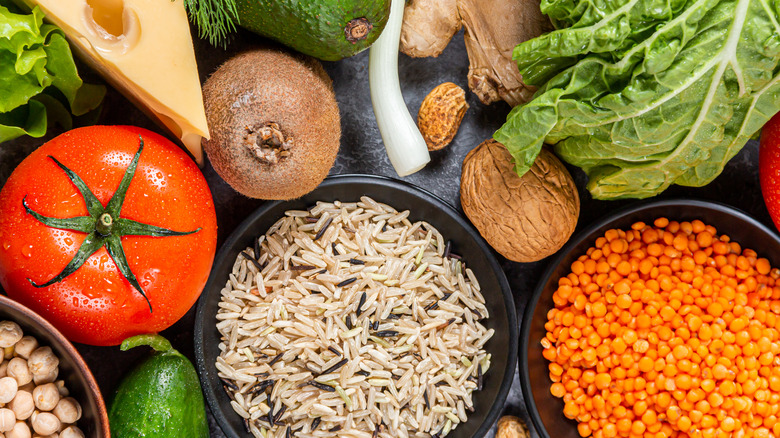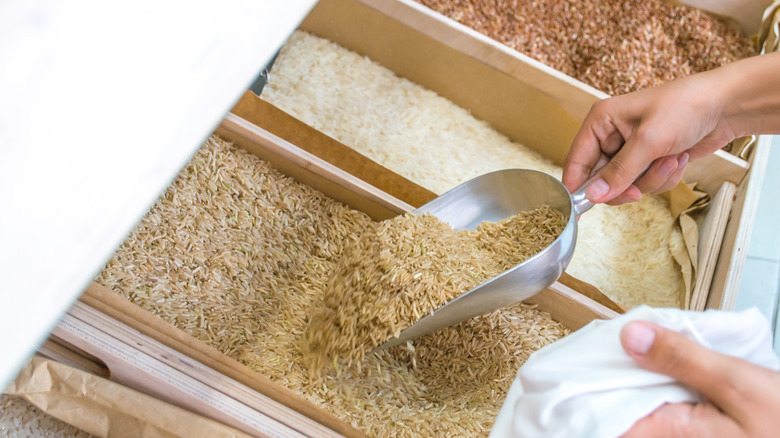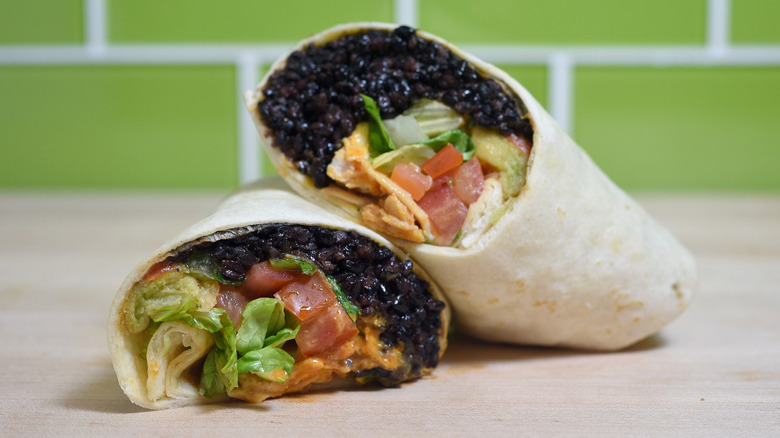What You Didn't Know About Black Rice
We may receive a commission on purchases made from links.
If you've never tried black rice, you're missing out — this versatile grain can be used in cool, refreshing salads, in a savory stir fry, and even in creamy desserts. Although not as common as its counterparts white and brown rice, the grain has been gaining in popularity in recent years, popping up on menus everywhere, from the southeast Asian restaurant Lukshon in Los Angeles to Squeeze Juice Co. in Boston.
Like brown rice, black rice is always a whole grain because its bran is left on, which imparts a chewy texture and a nutty flavor (via MasterClass). But apart from its flavor, black rice undoubtedly owes much of its growing popularity to its nutritional profile. The grain is rich in antioxidants which are both water and fat-soluble, meaning they might benefit multiple parts of the body. And like all types of whole grain rice, black rice has a low glycemic index, which means the sugars it contains are absorbed more slowly and won't spike blood sugar in the way that simple carbohydrates do.
Black rice is considered the forbidden grain
Many know black rice as "forbidden" rice, but where does that name come from? As it turns out, the Chinese variety of black rice, typically grown in Zhezhiang in northern China, was in ancient times reserved for the country's aristocracy, which meant no "commoners" could eat it, according to MasterClass. For this reason black rice is still sometimes referred to as "emperor's rice," according to The Spruce Eats. Black rice has a low yield, producing only about 10 percent of the harvest of other types of rice, which contributes to its cachet.
According to MasterClass, in northern China, black rice is typically prepared as congee, a simple rice porridge that is typically eaten for breakfast and can be served plain or with toppings such as scallions, soy sauce, or a poached egg. It's a firm, not sticky, grain, and is therefore well suited to cold rice salads, or just as a side dish to accompany meat, fish, and vegetables.
Other varieties of black rice
In addition to Chinese black rice, which is perhaps the most common, there are two other varieties of the grain that are worth getting to know. According to MasterClass, black sticky rice is a long-grain, glutinous rice that's often used in Thai desserts. Usually mixed with white sticky rice and steamed, varieties of the sweets are sold in Thai markets, according to Thai Food & Travel. At home, it's easy to make into a simple rice pudding with coconut milk and brown sugar, per The Spruce Eats.
Black Japonica rice, technically a hybrid of short-grain black rice and medium-grain red rice, was developed by the Lundberg brothers, fourth-generation rice growers now located in California (via ckbk). Genetically about 25 percent of the former and 75 percent of the latter, black Japonica rice cooks up nutty, with the whole grain quality of wheat berries, according to Jeffrey Alford and Naomi Duguid, authors of the book Seductions of Rice. It's a firm grain that stands up well in soups or stews, retaining its texture even through various reheatings.
Black rice is a nutritional powerhouse
As mentioned above, much of black rice's appeal lies in its nutritional profile, which is quite robust. According to MasterClass, the grain is rich in fiber and protein, meaning it can keep you feeling much fuller than white or brown rice. It's also packed with iron, which can contribute to enhanced energy and focus, as well as keep the immune system up and running (via Medical News Today). Black rice, which is really a shade of deep purple, is rich in anthocyanin, an antioxidant pigment also found in eggplants and blackberries (via MasterClass).
In traditional Chinese medicine, according to The Spruce Eats, black rice is considered a blood tonic, thought to stimulate circulation and boost one's life force, and is also said to fortify the kidneys and liver, boost eyesight, and lower high blood pressure (via Balance Point Acupuncture and Integrative Medicine). Now that's a superfood!
Where to find black rice
Once a specialty food item, black rice used to require some dedication to find among the shelves of gourmet food shops, health food stores, and Asian markets (via The Spruce Eats). Today, thanks to its growing popularity, it's much easier to find. Any store with a large selection of gourmet food items should have black rice — think Whole Foods, Target, and Walmart. Online retailers such as Amazon also carry it, and you can order it directly from brands including Lundberg Family Farms, Lotus Foods, and Thrive Market.
Dining out? Black rice is becoming more common on restaurant menus, too. Look for it at Asian fusion spots, sushi restaurants, and health food cafés that serve rice bowls. Tons of Thai restaurants also serve black rice, especially in the form of black sticky rice as a dessert. Just remember that the menu might refer to black rice as "emperor's" or "forbidden" rice.
How to cook black rice
Cooking up black rice at home is simple — just follow the package instructions on whichever rice you buy. Typically, to cook black rice, you use a two-to-one ratio of water to rice. Once the water comes to a boil, you add the grains and simmer, with a lid on, until all the water has been absorbed (via The Spruce Eats). Because black rice is a whole grain, with its bran coat intact, it does take longer to cook than most varieties of white and even brown rice. Lundberg's Black Pearl Rice, for example, takes 30 to 35 minutes to fully cook (via Lundberg Family Farms).
You can also cook black rice in a rice cooker, according to Lundberg Family Farms, but you might need to add one to two additional tablespoons of water. Black rice makes a wonderful substitute pretty much anywhere you'd use white, or especially, brown rice. For dessert, don't forget to try out any of the widely available recipes for Thai black sticky rice, since it's a delicious and healthy way to enjoy this special grain's sweet side.
